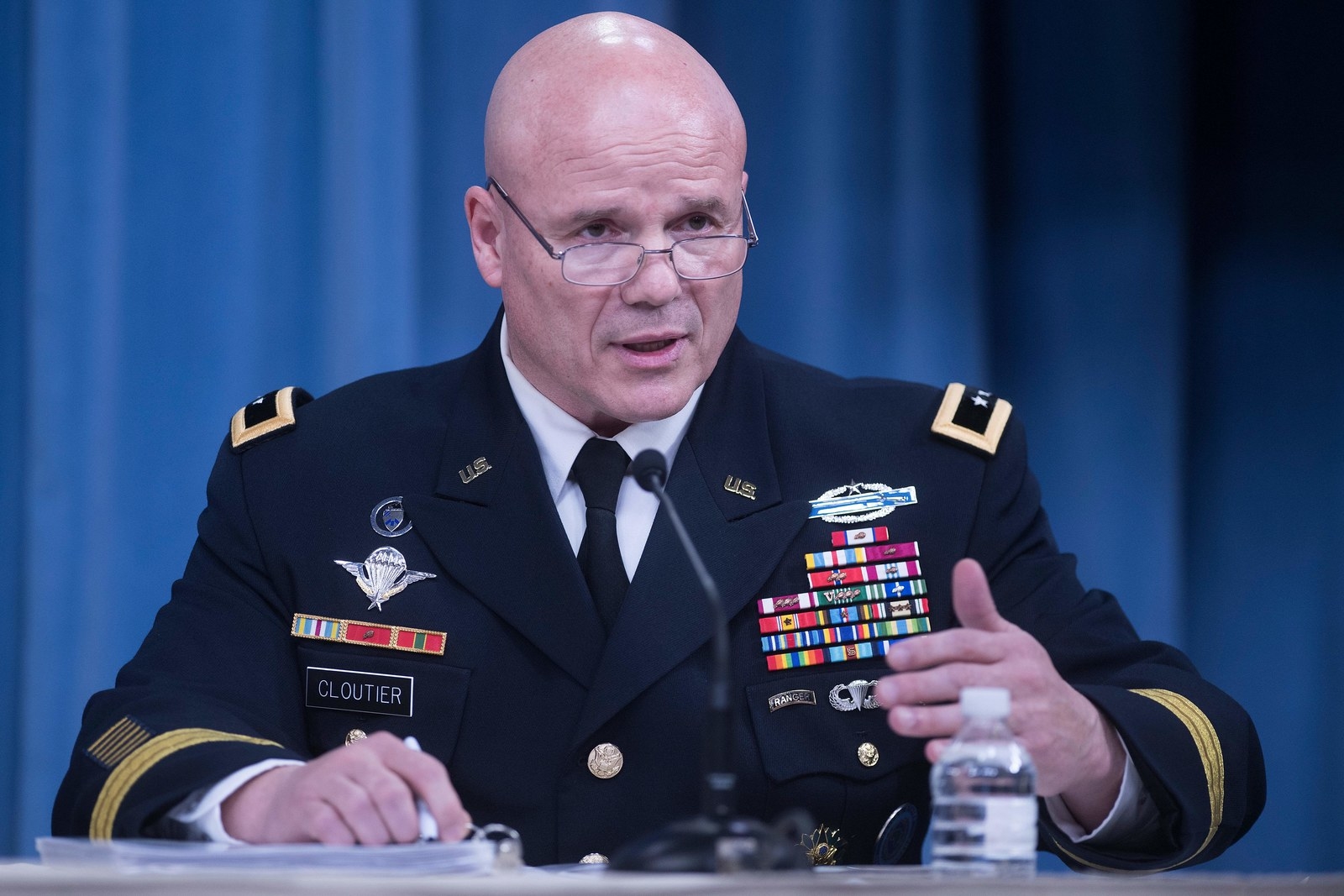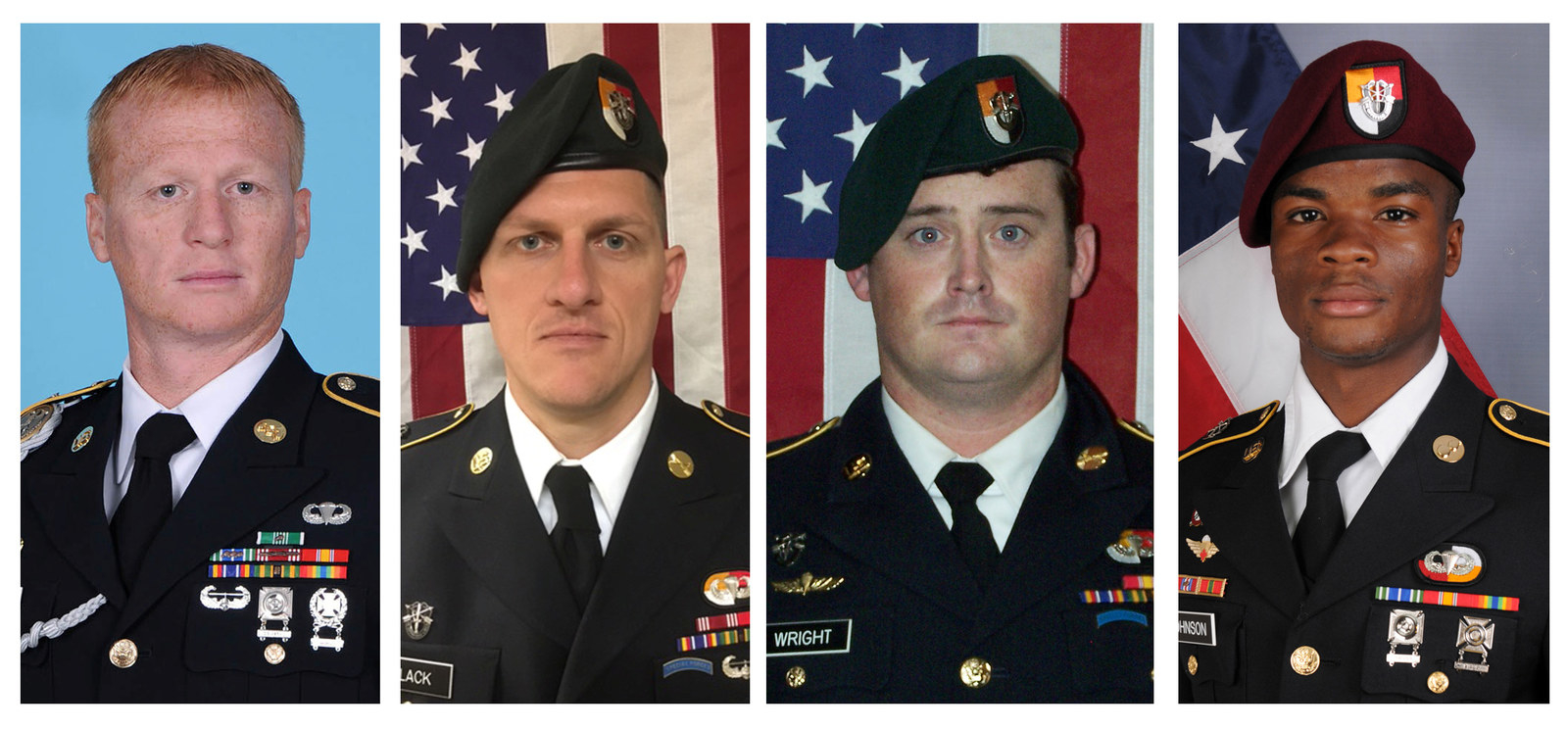
They were outnumbered, outmaneuvered, and outgunned.
That’s the simple answer in the Pentagon’s long-awaited report on how four US soldiers were killed last October in a brutal ambush in a remote border region of Niger where most Americans didn't know their country was at war.
The report, a result of a seven-month investigation, a summary of which was released on Thursday, does not answer why US soldiers found themselves at such a disadvantage. But it paints a dramatic picture of a mission that everyone thought would be routine going bad.
After being separated from his team, unable to get back into his vehicle and under heavy fire, Sgt. La David Johnson fled more than half a mile on foot. He ran the last quarter of a mile alone after the two Nigerien soldiers with him were gunned down by the dozens of ISIS-linked militants pursuing them.
Under the only cover he could find in the barren landscape — a single thorny tree — he “continued to return fire against the pursuing enemy.” But the enemy closed in, and Johnson was shot and killed.
His body was not recovered for 48 hours, giving rise to speculation he’d been captured before he died. But Pentagon officials said there was no truth to that speculation; Johnson died quickly of his wounds, the Pentagon said, as did the other three dead Americans, Staff Sgts. Bryan Black, Dustin Wright, and Jeremiah Johnson, who were killed near the initial ambush site.
He “died actively engaging the enemy,” said Marine Gen. Thomas Waldhauser, who heads the US Africa Command, or AFRICOM. “He was never captured alive; his hands were never bound.”
The document does not explain the “additional human remains” that the Pentagon said it discovered at the site where Johnson’s body was found on Nov. 12.
In the months since the Oct. 4 battle, speculation had swirled around the events, raising questions about whether the unit had been authorized to be there; why it had been sent on an unplanned hunt for a suspected terrorist leader near the border with Mali; whether the Americans had been betrayed by the leaders in the village of Tongo Tongo where they had stopped; and whether French aerial support had arrived too late to assist.
But in the end, Pentagon investigators concluded that none of that played a significant role in the deaths of the four Americans. Instead, the answers to what took place were simpler and more brutal:
— The detachment of American and Nigerien soldiers, with their eight vehicles, were overwhelmed by a large enemy force of perhaps 100 terrorists.
— The 12 American and 30 Nigerien soldiers were surprised and unprepared; they had to step out of their vehicles to put on their body armor.
— They ran out of ammunition and got separated from one another.
— They didn’t realize the serious problem they were in for nearly an hour when the survivors finally called for air support. They then promptly destroyed their radios, fearing they were about to be overrun. By then, three of the four Americans were already dead and La David Johnson soon would be.
The public eight-page summary of the 6,000-page classified report by US Africa Command, and a digital video recreation shown to reporters, provided new details about the battle.

According to the report, when militants on motorcycles and pickup trucks “massed and began to envelop” the smaller team, attacking them with small arms and rocket-propelled grenade launchers, the US and Nigerien troops initially engaged. But “realizing then that the team was significantly outnumbered by a well-trained force” the team commander ordered the unit to withdraw.
After reaching the cover of some trees, the rest of the unit dug into a defensive position and called for help for the first time, 53 minutes into the firefight, according to the report. French Mirage jets arrived 47 minutes later but were unable to tell the remaining soldiers from the enemy. So instead of opening fire, they flew low over the scene in “four separate shows of force” that caused the militants to retreat, “likely saving the lives” of the eight US soldiers who survived.
The report describes US troops as unequipped and partly untrained for this scenario, but it does not hold senior officials accountable for putting them in that situation. Instead, it casts blame on “a general lack of situational awareness and command oversight at every level” and on “individual, organizational, and institutional failures and deficiencies.”
It states there was "no single failure or deficiency was the sole reason for the events" on Oct. 4.
The summary made no effort to explore the contradiction between what Joint Chiefs Chair Marine Gen. Joseph Dunford told reporters after the attack, that under the military’s rules, US troops in Niger can accompany local forces only on missions when "the chances of enemy contact are unlikely,” and the fact that they were ambushed in a place known to be sympathetic to local ISIS affiliates and where the UN had tracked 46 attacks in the previous year and a half that left dozens of Nigerien soldiers dead.
Nigerien military officials told BuzzFeed News in December that US soldiers walked into a hornet’s nest of militants with insufficient intelligence, while a series of “negligent” decisions during the attack handed an accidental victory to an ISIS offshoot. The US military doesn't always seem to understand that in this militant-controlled terrain, intelligence gathering is more valuable than firepower, they said.
The investigation uncovered that the team initially went on an unapproved, high-risk mission, but military officials stressed that it was unconnected from the eventual ambush. After two junior officers "inaccurately characterized the nature of the mission” by submitting a proposal with a much lower risk, they actually went on a mission to kill or capture a local ISIS leader, whom they didn’t end up finding, according to the document.

“That mission is over and done, despite not properly being characterized,” said Army Maj. Gen. Roger Cloutier Jr., the AFRICOM commander’s chief of staff who led the investigation. “They are returning back to base. That mission does not result in the attack in Tongo Tongo.”
On their return, they stopped for water and to meet with village leaders, where they were ambushed.
Nigerien officials have had a much simpler assessment since day one, saying that the Oct. 4 ambush was the result of a "failure of human intelligence." Someone in the village tipped off the militants as the village elder seemed to stall them. With no aerial surveillance on the surrounding area, the team was not alerted to the nearly 100 militants that surprised them.
In the aftermath of the attack, Nigerien troops also said they had wondered why the US troops were so lightly armed, with one soldier who met them a day earlier noting that they were traveling in unarmored vehicles and dressed in T-shirts and baseball caps with no body armor.
"I was surprised that the Americans would go out into the zone with such a light convoy and no air cover, no drones to keep watch over them," the soldier told CNN at the time.
A video recreation of the incident shown to reporters at the Pentagon on Thursday seems to confirm that the soldiers, upon getting out of their vehicles, “donned personal protective equipment and returned small arms fire” when they were ambushed.
Waldhauser on Thursday said the special operations component had done an assessment for armored vehicles and “determined, a while back, that they weren’t necessary” taking into account the roads and the weather. Going forward, armored vehicles will be given to those teams “as an option…they should have the choice.”
The conclusions also point to the risks of counterterrorism missions within AFRICOM, an underresourced command whose operations cover a vast area. The US has roughly 800 troops in Niger, with about 6,000 across Africa. Months before the attack, AFRICOM had warned Congress that its troops faced greater risk because they didn't have access to medical evacuation equipment and drones.
The digital recreation by military investigators confirms footage posted by an ISIS-linked group in March, which they said came from the helmet camera of one of the US soldiers who was killed. At the time, a Pentagon spokesperson warned reporters that they would be "complicit" with the terrorist group if they publicized it.
The video shows three US soldiers taking shelter behind a slow-moving, unarmored SUV behind reddish clouds from smoke grenades when they are overwhelmed by a larger group of militants armed with grenades and machine guns. At the end of the video, the soldier wearing the helmet camera goes down and militants come into view, shooting him again at point-blank range.

“As enemy fighters advanced through the ambush site, they fired several additional bursts into the bodies of the three soldiers,” the summary of the report says of Wright, Johnson, and Black, echoing the footage.
In a statement, the Pentagon on Thursday said that Defense Secretary James Mattis was directing the US Army to review the training that special forces receive before deployment.
The probe "concluded there are institutional and organizational issues, not isolated to this event, that must be addressed immediately by the Department of Defense,” Pentagon spokesperson Dana White said in a statement.
Family members and lawmakers who were given more detailed briefings on the investigation in recent weeks say they still have unanswered questions.
The families of the soldiers who were killed went through grueling briefings, some of them up to eight hours, that they say did not provide the closure they were promised for seven months.
Virginia Democratic Sen. Tim Kaine said he left the classified, “very explosive” briefing “somewhat shocked” and promised that “people will be held accountable.”
The report does not recommend disciplinary action against those involved.

